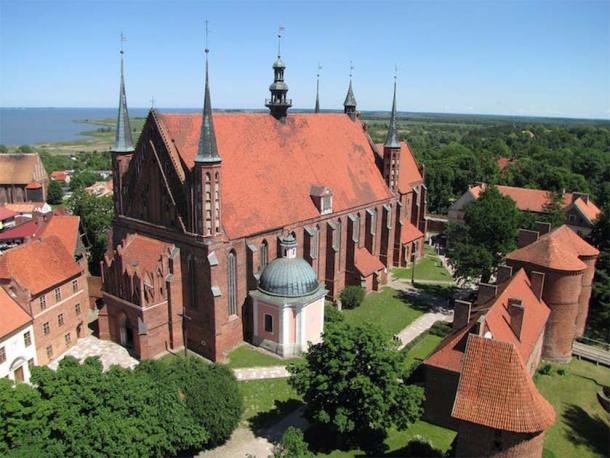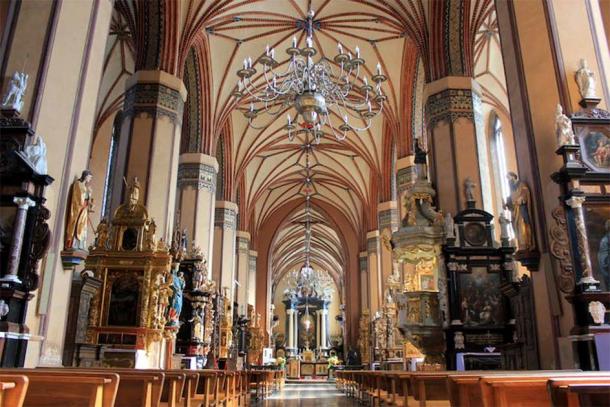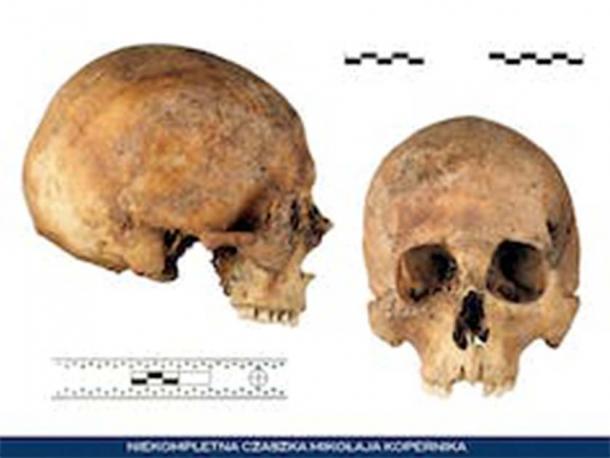Darius von Güttner Sporzynski / The Conversation
Nicolaus Copernicus was the astronomer who demonstrated five centuries ago that the Earth revolves around the Sun, and not the other way around. A true Renaissance man, he also worked as a mathematician, engineer, author, economic theorist, and physician.
Upon his death in 1543 in Frombork, Poland, Copernicus was buried in the local cathedral. Over the following centuries, his grave site was lost to history.
Portrait of Nicolaus Copernicus from Toruń City Hall (ca. 1580). (Regional Museum in Toruń/ Public domain)
Who was Copernicus?
Nicolaus Copernicusor Mikołaj Kopernik in Polish, was born in Toruń in 1473. He was the youngest of four children born to a local merchant.
After his father's death, Copernicus' uncle took charge of his education. The young scholar studied first at the University of Kraków between 1491 and 1494, then at the Italian universities of Bologna, Padua and Ferrara.
After studying medicine, canon law, mathematical astronomy, and astrology, Copernicus returned to his homeland in 1503. He then worked for his influential uncle, Lucas Watzenrode the Younger, who was the prince-bishop of Warmia.
Copernicus He worked as a doctor While continuing his research in mathematics. At that time, astronomy and music were considered branches of mathematics.
During this period, he formulated two influential economic theories. In 1517, he developed Quantity theory of moneyWhich was later reformulated by John Locke and David Hume, and popularized by Milton Friedman in the 1960s. In 1519, Copernicus also introduced the concept now known as… Gresham's lawIt is a monetary principle that deals with the circulation and valuation of money.
Nicolaus Copernicus was buried in Frombork Cathedral. (Holger Weinandt/CCP-SA 3.0)
Copernican model of the universe
The cornerstone of Copernicus's contributions to science was his revolutionary model of the universe. In contrast to the prevailing Ptolemaic model, which emphasized the Earth as the fixed center of the universe, Copernicus argued that the Earth and the other planets revolved around the Sun.
Copernicus was also able to compare the sizes of the planets' orbits by expressing them in terms of the distance between the Sun and the Earth.
Copernicus feared how his works would be received by the church and his fellow scientists. His greatest works,De Revolutionibus Orbium Coelestium(On the Motion of the Celestial Bodies), was not published until just before his death in 1543.
The publication of this work paved the way for groundbreaking shifts in our understanding of the universe, paving the way for future astronomers like Galileo, who was born more than 20 years after Copernicus' death.
Searching for Copernicus
Frombork Cathedral serves as the final resting place for more than 100 people, most of whom lie in unmarked graves.
There have been several failed attempts to locate the remains of Copernicus, which date back to the 16th and 17th centuries. Another failed attempt was made by the French Emperor Napoleon after the Battle of Eylau in 1807. Napoleon had great respect for Copernicus as a polymath, mathematician, and astronomer.
Historians believe that Copernicus was buried near a certain altar in Frombork Cathedral. (Julian Nitsha/CC BY SA 3.0)
In 2005, a group of Polish archaeologists conducted research.
They were guided by the theory of historian Jerzy Sikorski, who claimed that Copernicus, who had served as canon of Frombork Cathedral, would have been buried near the altar of the cathedral for which he had been responsible during his tenure. This was the Altar of Saint Wacquaf, now known as the Altar of the Holy Cross.
Thirteen skeletons were discovered near this altar, including a skeleton Incomplete skeleton It belongs to a man between 60 and 70 years old. This skeleton has been specifically identified as being closest to that of Copernicus.
A skull believed to belong to Copernicus. Dariusz Zajdil / Centralne Laboratorium Kryminalistyczne Policji
Forensic science
The skeleton's skull served as the basis for facial reconstruction.
In addition to morphological studies, DNA analysis is often used for Identify historical or ancient remains. In the case of the supposed Copernican remains, genetic identification was possible due to the well-preserved condition of the teeth.
The major challenge is locating a suitable source for reference materials. There were no known remains of any of Copernicus's relatives.
Improbable search
However, in 2006, a new source of DNA reference materials emerged. An astronomical reference book used by Copernicus for many years has been found to contain poetry between its pages.
This book was transported to Sweden as spoils of war after the Swedish invasion of Poland in the mid-17th century. It is currently in the possession of the Gustavianum Museum at Uppsala University.
Close examination of the book revealed several hairs, believed to belong to the book's primary user, Copernicus himself. Hence, these hairs were evaluated as potential reference materials for genetic comparison with teeth and bones recovered from the grave.
Poetry was compared with DNA from teeth and bones From the discovered skeleton. Both mitochondrial DNA from the teeth and the skeletal sample matched that found in the hair, strongly suggesting that the remains were indeed those of Nicolaus Copernicus.
The multidisciplinary effort, involving archaeological excavation, morphological studies and advanced DNA analysis, has produced a convincing result.
The remains discovered near the Altar of the Holy Cross in Frombork Cathedral are very likely those of Nicolaus Copernicus. This monumental discovery not only sheds light on the final resting place of one of the most influential figures in the history of science, but also showcases the depth and sophistication of modern scientific methods in supporting historical data.
The article “The Strange Story of Copernicus’ Tomb” by Darius von Göttner Sporzynski Originally published on Conversation It has been republished under a Creative Commons license.
Top image: Astronomer Copernicus, or Conversations with God, by Jan Matejko. source: Public domain

“Infuriatingly humble alcohol fanatic. Unapologetic beer practitioner. Analyst.”



